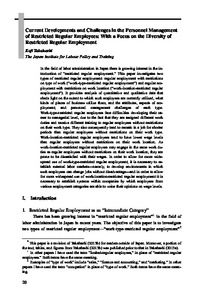Current developments and challenges in the personnel management of restricted regular employees: with a focus on the diversity of restricted regular employment

2016
13
2
Spring
20-45
employment ; labour flexibility ; personnel management
Employment
English
Bibliogr.
"In the field of labor administration in Japan there is growing interest in the introduction of “restricted regular employment.” This paper investigates two types of restricted regular employment: regular employment with restrictions on type of work (“work-type-restricted regular employment”) and regular employment with restrictions on work location (“work-location-restricted regular employment”). It provides analysis of quantitative and qualitative data that sheds light on the extent to which such employees are currently utilized, what kinds of places of business utilize them, and the attributes, aspects of employment, and personnel management challenges of each type. Work-type-restricted regular employees face difficulties developing their career to managerial level, due to the fact that they are assigned different work duties and receive different training to regular employees without restrictions on their work type. They also consequently tend to remain in a job for shorter periods than regular employees without restrictions on their work type. Work-location-restricted regular employees tend to have lower wage levels than regular employees without restrictions on their work location. As work-location-restricted regular employees may engage in the same work duties as regular employees without restrictions on their work location, they are prone to be dissatisfied with their wages. In order to allow for more widespread use of work-type-restricted regular employment, it is necessary to establish external labor markets—namely, to develop environments in which such employees can change jobs without disadvantage—and in order to allow for more widespread use of work-location-restricted regular employment it is necessary to establish systems within companies by which employees from various employment categories are able to voice their opinions on wage levels."
Digital
The ETUI is co-funded by the European Union. Views and opinions expressed are however those of the author(s) only and do not necessarily reflect those of the European Union or the ETUI.